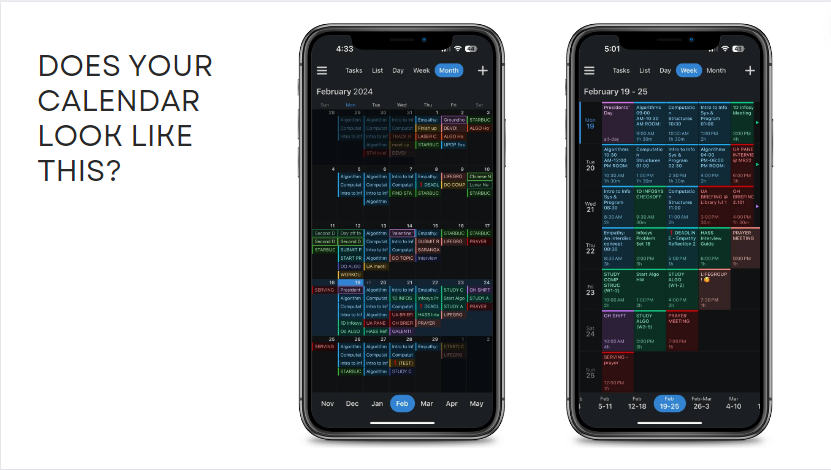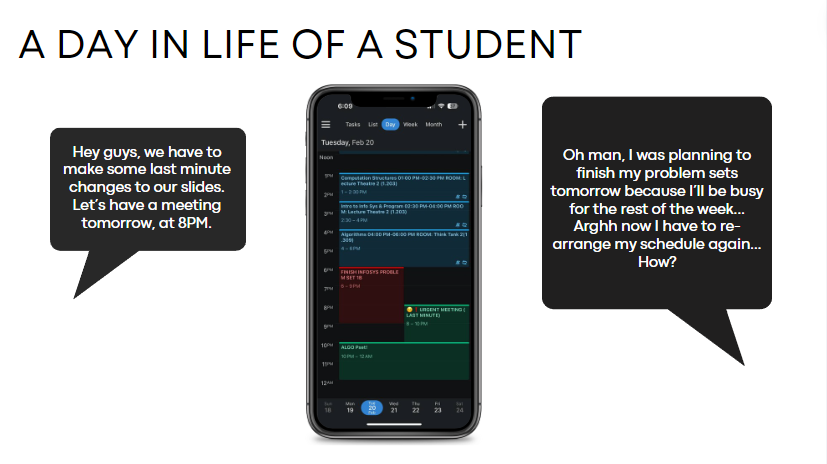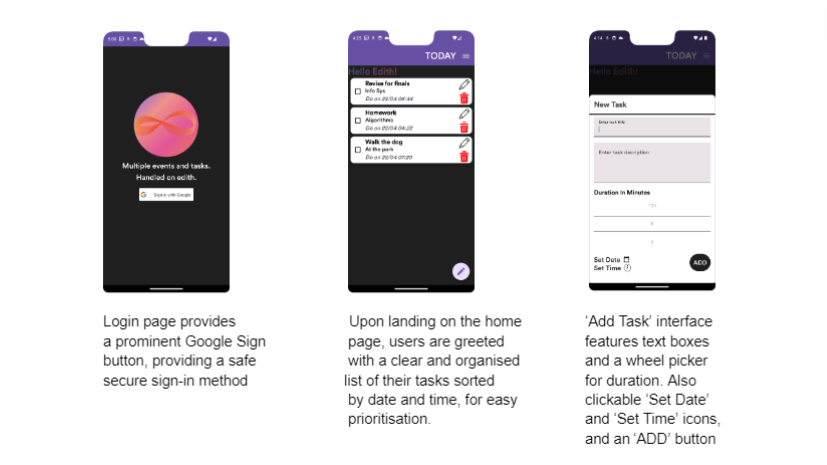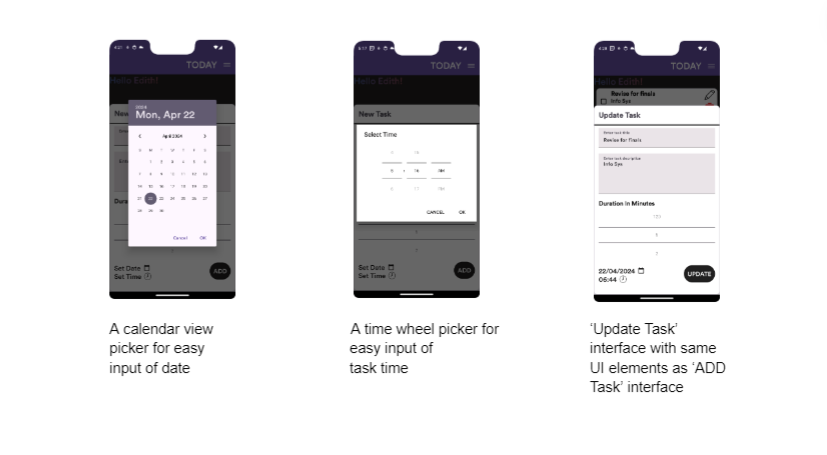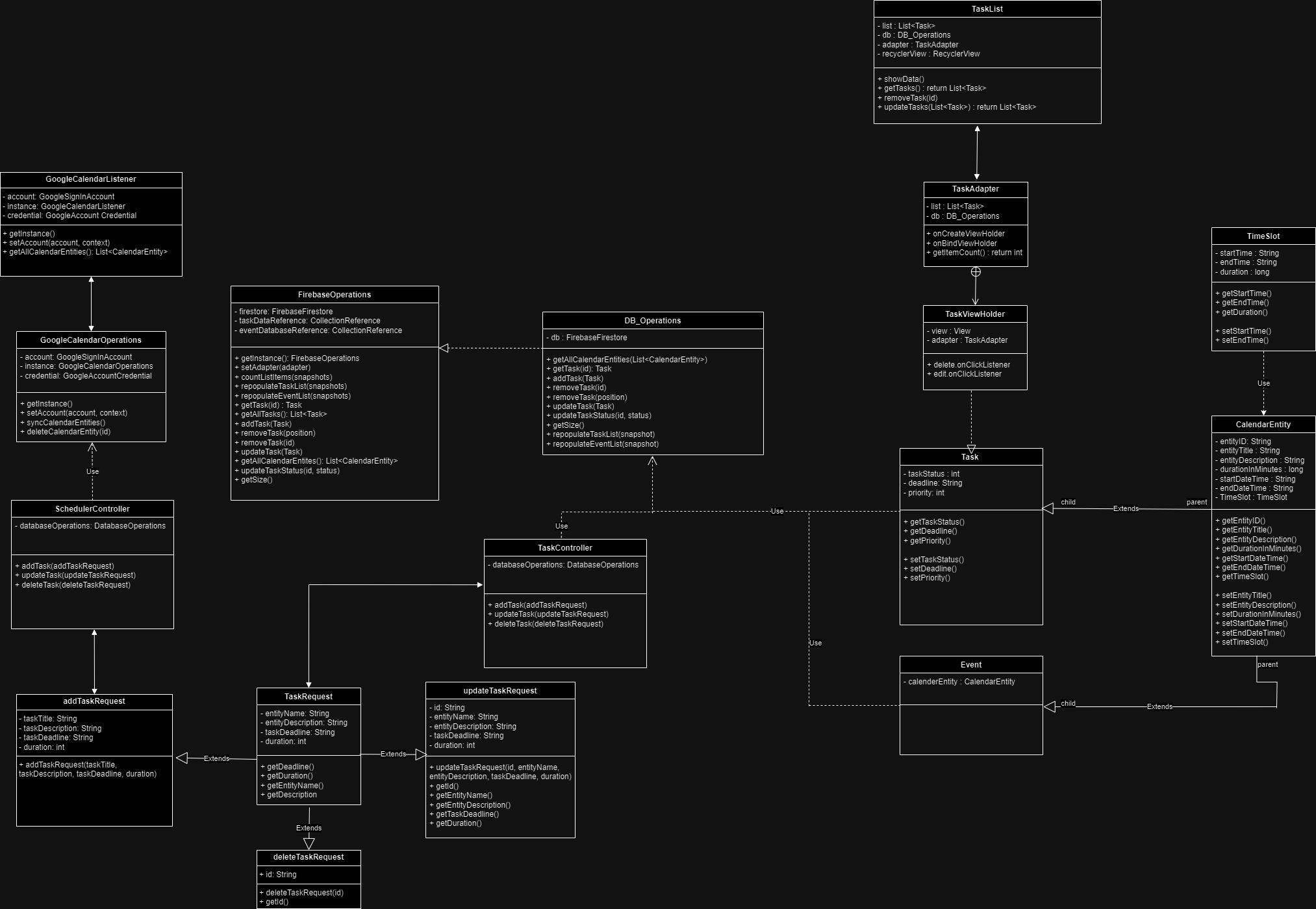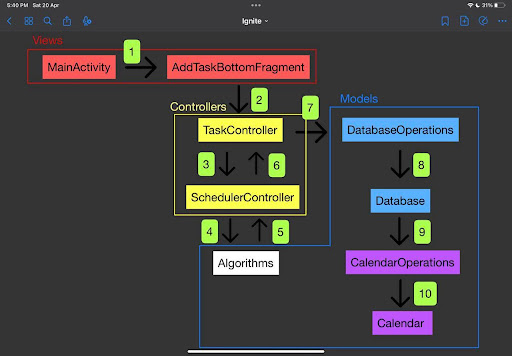| Name | ID | Roles |
|---|---|---|
| Lim Donggeon | 1007068 | UI/UX Design |
| Vancence Ho | 1007239 | Front-End Development |
| Douglas Tan | 1006656 | Algorithm Design |
| Lindero Dianthe Marithe Lumagui | 1007213 | Front-End Development |
| Andrew Foo | 1007209 | Back-End Development |
| Chu Jeng Kuen | 1006920 | Algorithm Design |
| David Ling De Wei | 1007175 | Back-End Development |
As students, juggling numerous commitments can often feel overwhelming. The arduous task of manually organising and prioritising tasks around existing events not only consumes precious time but also adds unnecessary stress to already packed schedules.
Which lead to us thinking, what if there was a solution to alleviate this burden? (Similar to how JARVIS plans schedules for Tony). We wanted an app that automates the entire process of task scheduling, revolutionising time management for students. With this innovative tool, everybody, not only students, can effortlessly input their tasks, and the app will seamlessly integrate them into their calendar, optimising schedules to maximise productivity and efficiency.
Inspired by this desire, our team envisioned an app that would one day be able to intake human-like natural language and be able to generate tasks required, automatically scheduling it based on its priority. Harnessing the power of automation, our app aims to empower not only students but everybody to focus more on other important aspects like your passions, while minimising the hassle of manual adjustments. Thus, our idea was sparked: EDITH a.k.a Events & Deadlines Intelligent Task Handler; an intuitive app designed to revolutionise time management for everybody, saving them valuable time and energy to devote to what truly matters.
Our application is built using concepts of Object-Oriented Programming (OOP), therefore it is easily scalable and flexible. In our application, we have chose to use Firebase as an option for our database. However, it is possible to apply other database systems easily to our application just by creating a new class containing operations from your intended database, an example from our implementation is as provided:
public void getTask(String id){
// code not shown
// attributes in table below
}| Attributes | Type | Requirement |
|---|---|---|
| entityID | String |
Required |
public void addTask(Task task){
// code not shown
// attributes in table below
}| Attributes | Type | Requirement |
|---|---|---|
| entityID | String |
Required |
| entityTitle | String |
Required |
| description | String |
Optional |
| isCompleted | boolean |
Optional |
| priority | Integer |
Optional |
| deadline | String |
Required |
| durationMinutes | Integer |
Required |
| start_time | String |
Required |
| timeSlot | String |
Required |
| updateRequired | boolean |
Optional |
| type | String |
Required |
public void removeTask(String id){
// code not shown
// attributes in table below
}| Attributes | Type | Requirement |
|---|---|---|
| entityID | String |
Required |
public void updateTask(Task task){
// code not shown
// attributes in table below
}| Attributes | Type | Requirement |
|---|---|---|
| entityID | String |
Required |
| entityTitle | String |
Required |
| description | String |
Optional |
| isCompleted | boolean |
Optional |
| priority | Integer |
Optional |
| deadline | String |
Required |
| durationMinutes | Integer |
Required |
| start_time | String |
Required |
| timeSlot | String |
Required |
| updateRequired | boolean |
Optional |
| type | String |
Required |
Additionally, establishing a database connection can be resource-intensive. By reusing a single instance of FirebaseOperations, the application can save resources as it doesn't need to repeatedly open and close connections to the Firebase database.
// Constructor
private FirebaseOperations(){
// code not shown
}
// Singleton Design Pattern
public static FirebaseOperations getInstance(){
if (instance == null){
instance = new FirebaseOperations();
}
return instance;
}public TaskAdapter(Context context, DatabaseOperations db){
FirebaseOperations dbOperations = FirebaseOperations.getInstance();
dbOperations.setAdapter(this);
mInflater = LayoutInflater.from(conten);
this.context = context;
this.db = db;
}
@NonNull
@Override
public TaskViewHolder onCreateViewHolder(@Nonnull ViewGroup parent, int viewType){
// code not shown
}
@Override
public void onBindViewHolder(@NonNull TaskViewHolder holder, int position){
// code not shown
}
@Override
public int getItemCount(){
return db.getSize();
}
public static class TaskViewHolder extends RecyclerView.ViewHolder{
// code not shown
} public static final int GOOGLE_SIGN_IN_CODE = 10005;
GoogleSignInOptions gso;
GoogleSignInClient signInClient;
gso = new GoogleSignInOptions.Builder(GoogleSignInOptions.DEFAULT_SIGN_IN)
.requestIdToken(getString(R.string.web_client_id)).requestEmail()
.requestScopes(new Scope("https://www.googleapis.com/auth/calendar"))
.build();
signInClient = GoogleSignIn.getClient(this, gso);
GoogleSignInAccount signInAccount = GoogleSignIn.getLastSignedInAccount(this);dependencies{
implementation("com.google.android.gms:play-services-location:21.2.")
implementation("com.google.android.gms:play-services-auth:21.0.0")
} private static FirebaseOperations instance = null;
private FirebaseFirestore firestore;
private CollectionReference taskDatabaseReference;
private CollectionReference eventDatabaseReference;dependencies {
implementation("com.google.firebase:firebase-firestore:24.11.0")
implementation("com.google.firebase:firebase-auth:22.3.1")
} private GoogleSignInAccount account;
private static GoogleCalendarOperations instance;
private GoogleAccountCredential credential;dependencies {
implementation("com.google.api-client:google-api-client-android:1.31.5")
implementation("com.google.api-client:google-api-client-gson:1.31.5")
implementation("com.google.apis:google-api-services-calendar:v3-rev20220715-2.0.0")
implementation("com.google.http-client:google-http-client-android:1.39.2")
implementation("com.google.http-client:google-http-client-jackson2:1.39.2")
}As for the reasons for our choice of data structure, we decided to utilize ArrayLists, firstly because it maintains the order of tasks as they were added, which is by deadline in our case. Secondly, it also provides constant-time performance for get and set operations. Lastly, it is resizable, where we do not need to create a new array to resize ourselves.
Compared to a tree data structure, an ArrayList data structure is more suitable for our use case because it allows for access to elements by index. Two examples, of why accessing by index is important in our program. Firstly, the onBindViewHolder method in the RecyclerView’s Adapter requires the position of the item to bind the correct data to the ViewHolder, it calls the get(position) of the arraylist to obtain data for that position. Secondly, when an event occurs on an item, like a click event, the position of the item directly corresponds to the same index within our underlying data structure. For example, in the TaskAdapter class, when edit icon is clicked, the editTask(int position) method is called with the position of the corresponding item. This same position is used to retrieve the corresponding task from the data structure for editing.
Next, we chose to utilize ArrayLists over LinkedLists because ArrayLists offer better performance for operations like add, get, set, than LinkedLists. LinkedLists offer better performance for operation like add and remove only at beginning or end of the list, which is not what we need for our purposes, therefore the ArrayList data structure is the better choice.
The ArrayList data structure we used in our program is a resizable array implementation of the List interface. It is part of the Java Collections Framework and resides in the java.util package.
In our getAllCalendarEntities method found in FirebaseOperation class, it retrieves all calendar entities from the Firebase database. Firstly an empty ArrayList of CalendarEntity objects named calendarEntities is created. Next we call the get method on the taskDatabaseReference, which is a reference to the “task” collection of our firestore database, to obtain all documents in the collection. We then attached an OnSuccessListener to the get method which will trigger when the get operation is successful. Inside our OnSuccessListener, the toObjects method is called on the QuerySnapshot object returned by the get method. This method converts each document in the “tasks” collection to a Task object. This Task object is a child class of CalendarEntity that we have defined. Now these Task objects can then be added to the CalendarEntities ArrayList we created. The method will then return calendarEntitites list.
Another example where we implemented algorithm is in our updateTaskStatus method also in our FirebaseOperations class. It takes in two parameters, id which is a string and status a boolean. The document method is called on taskDatabaseReference with id passed into its argument, giving us a DocumentReference to the document in the “task” collection with the given document ID. The update method is then called on the DocumentReference with the field “status” and it updates the corresponding value to the new boolean status argument passed.
In both of these examples, firestore handles core data retrieval algorithms, both for fetching all documents in a collection and reading individual documents by document ID, therefore we did not have to implement our algorithm, since Firestore libraries provided the necessary functionality.
We deeply resonate with the problem statement as it is a problem experienced by all of us as students. We believe this app has great potential to turn into an actual marketable product.
Throughout this course, we have built a prototype and proven that the idea is feasible, and have received positive feedback during the showcase. Moving forward, we will work on improving the app interface to promote a better user experience while improving the robustness and accuracy of our algorithms.
